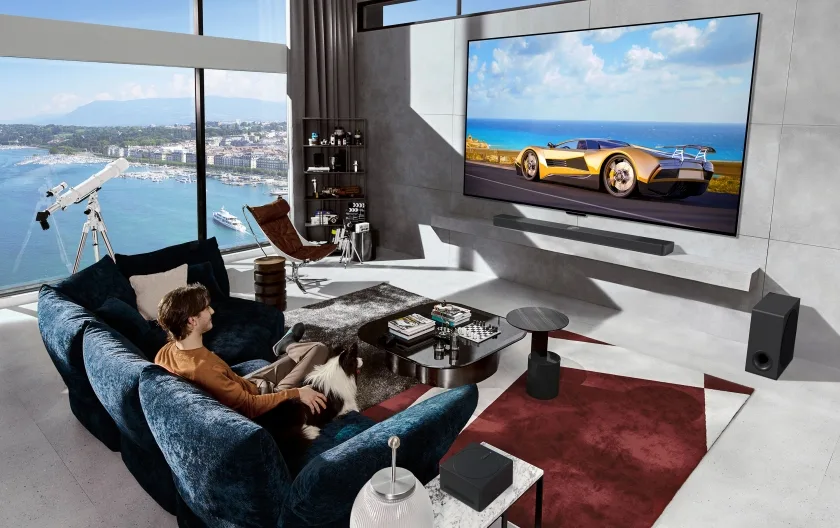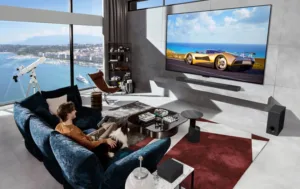What Display Daily thinks: It’s going to be interesting to see how LG’s TV fortunes pan out this year because it feels like the company has a lot going on, and gaining market share or lost ground in TV sales is not one of the higher priorities.
The Zero Connect Box on the wireless Signature OLED M always eludes me. It seems to get a lot of press, but it is less than an ideal solution for a so-called wireless TV, especially at the premium pricing that it commands. There is an obvious thread of marketing storytelling here with wirelesss TVs, webOS 2024, and AI processor upgrades, all suggesting that LG is building a proprietary eco system for its TV users, one that has the most advanced technologies available, but I am disappointed that webOS 2024 is not a more significant upgrade.
I get that the AI processor thing is good marketing practice, too. You can stick AI on a bucket of fried chicken and sell it for a premium over KFC, but in the context of its value, it’s debatable. In this case here, there’s more being done with algorithmic display enhancement, and it squeezes under the AI label, but it doesn’t seem like the processing does much for the user experience on the webOS front or in any other way.
I suspect the biggest wow factors coming from LG at CES 2024 will be around its automotive products, and I suspect that TV lineups won’t be the focus on the industry event. However, I did hope for a lot more from webOS 2024. It’s disappointing not to see something major in terms of the user experience, one that is solely in the realm of the OS and software applications. Maybe that is too much to expect for a “consumer electronics” event, but I can’t think of a better time to set the agenda for webOS than at CES 2024. This doesn’t feel like it’s it.
LG’s 2024 OLED TV Lineup, AI, and WebOS Upgrade
LG Electronics has recently introduced their 2024 OLED TV lineup. The highlight of this lineup is the LG Signature OLED M, a 97-inch wireless OLED TV, which is part of a range that includes sizes up to 65 inches.

A key feature of the new lineup is the enhanced artificial intelligence (AI) processor, dubbed Alpha 11, which offers substantially improved graphics and processing speeds. This processor facilitates advanced AI upscaling for clearer images and dynamic tone mapping for refined contrast. In addition to picture quality, LG claims, with AI, the TVs boast superior sound technology, converting 2-channel audio into virtual 11.1.2 channels for a richer sound experience. The OLED EVO models, excluding the 97-inch version, have also received clearMR certification from VESA. Gaming features are also a strong focus, with a 144Hz refresh rate, compatibility with G-SYNC and Radeon FreeSync, and comprehensive HDMI 2.1 support. In addition, LG has expanded its premium TV market presence with the QNED TV range, equipped with MiniLED technology and the AI Alpha 8 processor. This lineup includes the new 98-inch model.
| Feature | LG M4 | LG G4 | LG C4 | LG B4 |
|---|---|---|---|---|
| Screen Sizes | 65″, 77″, 83″, 97″ | 55″, 65″, 77″, 83″, 97″ | 42″, 48″, 55″, 65″, 77″, 83″ | 48″, 55″, 65″, 77″ |
| Processor | Alpha 11 AI | Alpha 11 AI | Alpha 9 AI | Alpha 8 AI |
| Wireless Audio | Yes, including Dolby Atmos | Yes, including Dolby Atmos | Yes | Yes |
| Refresh Rate | Up to 4K 144Hz | Up to 4K 144Hz (up to 83″) | 144Hz | 120 Hz |
| Gaming Features | AMD FreeSync, Nvidia GSync | AMD FreeSync, Nvidia GSync | AMD FreeSync, Nvidia GSync | AMD FreeSync, Nvidia GSync |
| AI Picture Pro Features | More detailed upscaling, new modes like ‘Director Tone’ | Similar to M4 | Similar to M4 and G4 | Improved AI image capabilities, in line with Alpha 9 Gen 7 from C3 |
| HDMI Ports | Four HDMI 2.1 ports | Four HDMI 2.1 ports | Four HDMI 2.1 ports | Four HDMI 2.1 ports |
LG’s webOS platform gets a shout out, too. LG has announced an update program. This update will also be available for all models in LG’s 2022 OLED TV series, including the OLED Flex, OLED Objet Collection Posé, and the QNED Mini LED 8K display. The key features include:
- Customization and Personalization: Users will be able to personalize their smart TV experience including choosing the content displayed on the screen, like music streaming services and video games.
- Quick Card UI: A new user interface designed to resemble smartphone interfaces. This UI will display content in a card format, with a large banner at the top, category tabs, selected services, and recommendations for curated content at the bottom.
- Advanced Security Technology: The update will have enhanced security features to protect against external threats like malware. However, specific details about the security technology haven’t been disclosed.
- Future Updates and Support: LG plans to continue updating and supporting webOS beyond this upgrade. They have committed to supporting 2024 webOS TVs until at least 2028.

